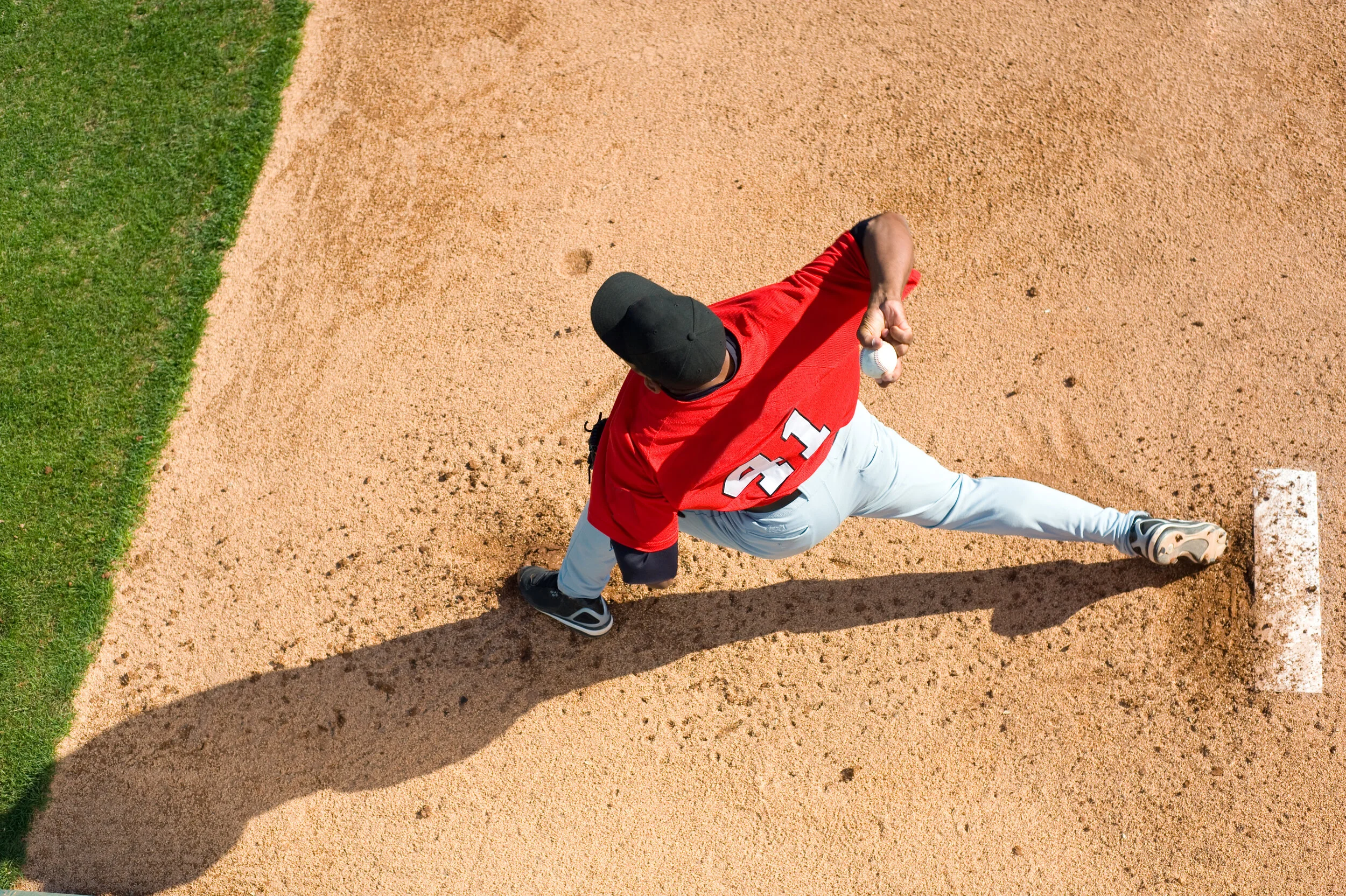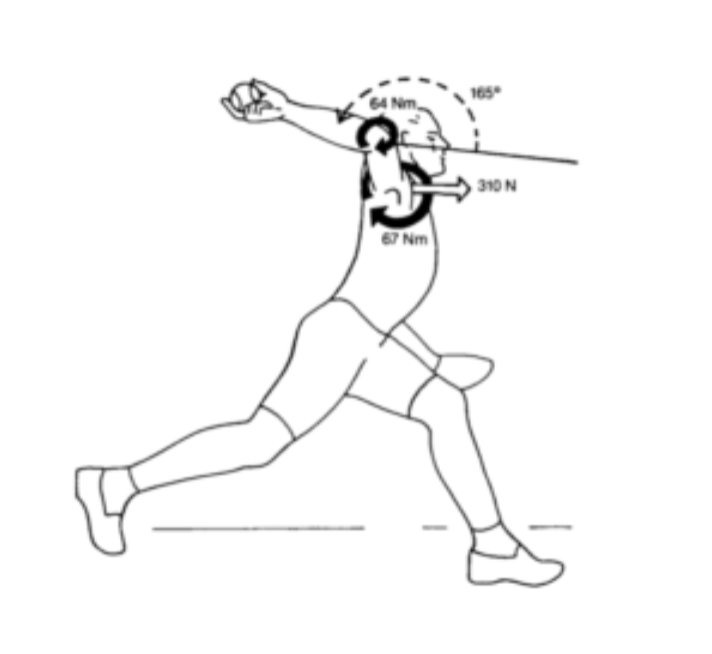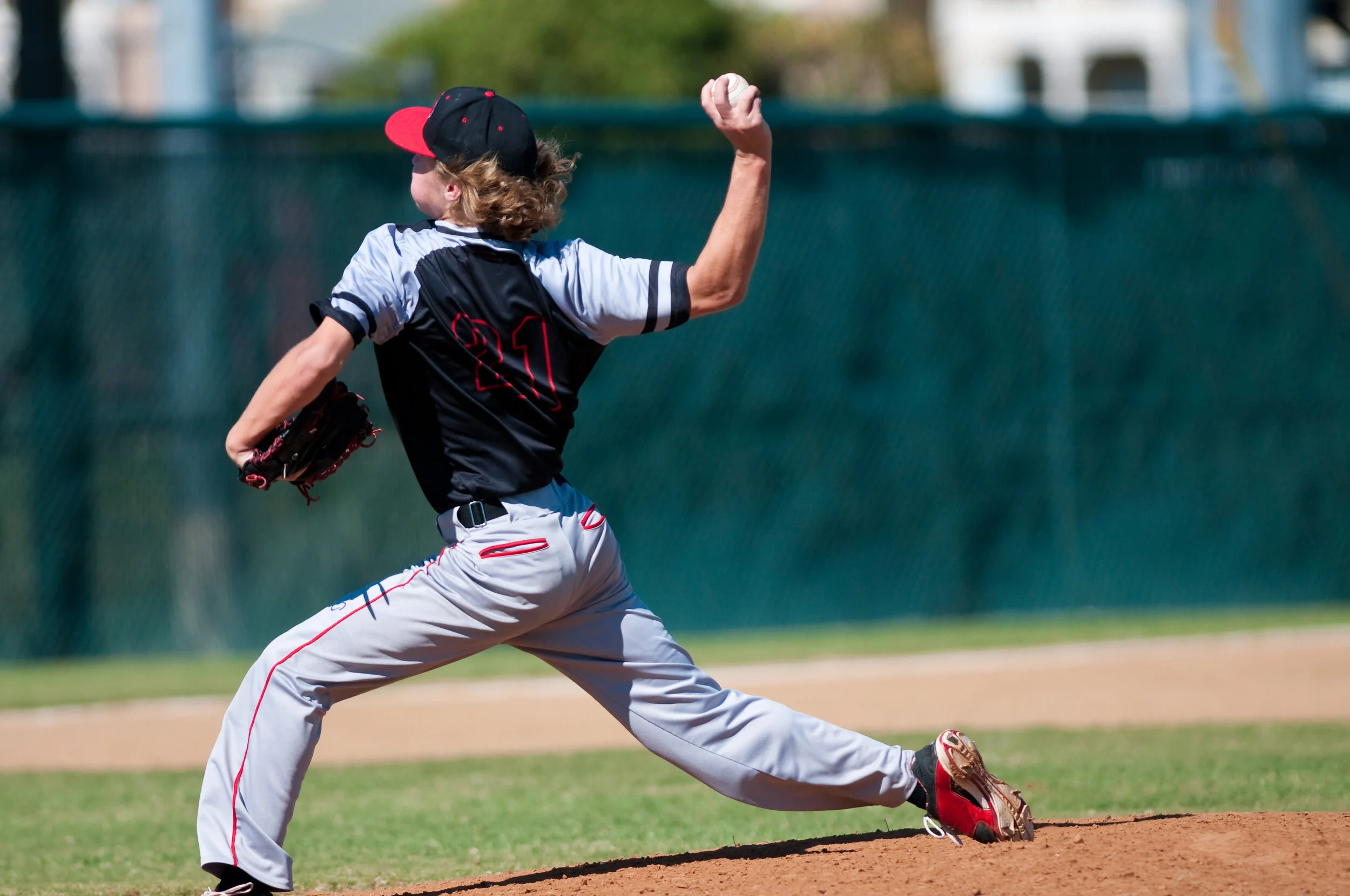Minimizing the Risk of Elbow Injuries in Throwers
The Biomechanics of the baseball throw:
Baseball fans thrive on interesting facts and statistics, but out of all of these facts, the science behind throwing a baseball has to be the most fascinating. The way that an elite athlete’s body can act as a coiled spring, transmitting the necessary forces to turn a baseball into an eye-blur is truly awe-inspiring. During the throw the elbow functions as a hinge joint, going through rapid extension at about 2400°/s for a professional pitcher. (Which is the equivalent of saying that in 1 second the arm could whip around 360° nearly 7 times). Accelerating to this incredible speed places a force on the Ulnar Collateral Ligament (UCL) of your elbow reaching 64Nm (nearly 50lbs).4 Not surprisingly, there is some fallout over time due to the transmission of this high force.
Rising Prevalence of Tommy John Surgery
Out of the possible injuries from throwing, UCL injuries have historically been the most devastating, and the injury rates seem to be rising every year. A large 2018 survey of professional baseball players showed that 13% of position players and 20% of pitchers had at some point in their career received Tommy John Surgery which was a 3% increase from 2012 to 2018 alone. 5 These rising injury rates seem to be linked to the rising pitch velocities over the past couple of decades, and these injury rates haven’t escaped young players. From the 90’s to the early 2000’s there was a 50% increase in Tommy John surgeries in high school baseball players aged 15 to 19 years old, and these rates continue to rise as well. 2
What are the Risk Factors for Elbow Injury In pitchers?
UCL ruptures are not like ACL ruptures which can happen without warning to an otherwise healthy ligament. There seems to be a lifespan on the UCL. While performing Tommy John surgery orthopedic surgeons almost always report a ligament that has frayed overtime.3 This tells us that UCL injuries result from repetitive stress overtime. For this reason, taking care of your arm when you are young is vital. Fortunately, we are beginning to understand which risk factors increase the likelihood of injury.
The #1 risk factor is overuse, and all other risk factors seem to branch off of this. There is a 400% increase in risk of injury observed for adolescents who throw more than 80 pitches per game. Pitching while fatigued, pitching for multiple teams, and pitching without adequate rest also adds to this risk. 1 Pitchers who also play the catcher position are at an increased risk of 2.7.6 Finally, pitching for >8 months of the year was correlated with a 500% increase in risk for Tommy John surgery.1 (In fact, I discuss why all young athletes should take 4 months off from an individual sport in my blog “Why We Should Avoid Specialization in Youth Sports”. Other risk factors not related to overuse include poor physical conditioning and poor pitching biomechanics.
“Energy required to throw a baseball is transferred from the lower extremities through the trunk/core into the arm-the body’s kinetic chain. This requires strength in the lower extremities, pelvis, and trunk to provide a sound base as well as a coordinated sequence of complex movements appropriately timed.”
Warning Signs for Baseball Pitchers & Coaches
Baseball experts are adamant that “Toughing it out” is not a good option in the case of pain while throwing. I was fortunate to train with Mike Reinold and his team of expert sports PTs at Champion Sports and Performance in Boston. Mike is the former PT and ATC for the Boston Red Sox. Mike’s elite clinic treats both the professional and adolescent athletes. Today he is well known for his contributions to baseball research, and he still does advising for MLB teams. While training with Mike he taught me some warning signs that he picked up while working with thousands of injured baseball players of all skill levels.
Pay special attention to elbow and forearm soreness or nerve symptoms that seem to shoot down to your ring and pinky fingers when throwing.
Don’t be fooled into thinking it’s only muscle soreness. If you tweak your UCL, the forearm muscles often work extra hard to protectively guard against valgus forces (the forces that would gap the elbow and stress the UCL when going into layback for a throw).
Increased gapping in your elbow or swelling may also cause some nerve symptoms stemming from the ulnar nerve running through the area. These can both be sources of discomfort on the inside of your elbow when throwing.
Other warning signs: decreased velocity, loss of pitch control, and difficulty warming up. If you would like to learn more from Mike Reinold, his website is wealth of information, and you can find a link to it under “Resources” at the end of this article.
“Player development is the holy grail of baseball. Velocity, movement, command, injury prevention: the teams that can develop these abilities better and faster than others are the ones that will be injury free and competing at the end of their respective season.”
How do you Protect Your Throwing Arm?
Physical Therapy Helps prevent injury in season and out
If you are picking up on any of these warning signs or simply want to optimize your performance, physical therapy can certainly help. You will want to go to a physical therapist who is experienced with baseball players and will know what to ask and what to look for. Your treatment program will likely incorporate some combination of strengthening, mobility, stability, sport specific exercises, and, if you were injured, a progressive return to your prior level activity. But there are also other specific things that a PT with baseball experience knows to look for. For example, research shows that if you lack range getting your arm fully overhead (into what we call shoulder flexion), then there is a subsequent increase in stress on the UCL while throwing.7 Similarly, we like to see your shoulder external rotation strength to be within 65-70% of your internal rotation strength. This represents adequate strength to safely decelerate your arm after throwing. The key muscles responsible for keeping the “ball” of your humeral head in the “socket” of your glenoid during a throw and then slowing down your arm after release are the rotator cuff muscles – specifically the teres minor and infraspinatus. Your body is extremely smart, and it won’t allow you to accelerate your arm any faster than your ability to decelerate it, so if you’ve lost some velocity over the course of a season, these fatigued muscles could be the culprit. A Physical Therapist knows how to identify if these deficits are present, design a program, and can help set you up for future success. If you aren’t injured, but you are looking to optimize, a great time to come in for a tune-up is directly after the season and before starting your off-season training.
“Early detection is very important to help reduce the risk of a mild injury becoming more severe, which could remove an athlete from several months of competition. ”
Healthy Habits
There are also several actions you can be taking independently to minimize the risk of UCL injury. Most importantly, you should listen to your body. If your arm hurts when throwing, tell your coach! A little PT might help. Typically, the longer you wait to rehab the injury, the more it sets you back. As mentioned earlier UCL injuries seem to result from repetitive damage over time, so don’t ignore that elbow pain! Also, since overuse is the biggest culprit for UCL injuries, pitchers of every age should be tracking their pitch count while in season. Check out the end of this article for some helpful resources.
You can also reduce your risk of injury by prepping well for the season. Structured off-season strength training programs and throwing programs have become the norm for competitive baseball players. A throwing program can help as a guide to make sure you are adequately prepared for the volume of an upcoming season, and then alternatively, the program can remind you to pump the breaks if you have a tendency to overdo throwing volume and intensity. Almost all high-level pitchers also incorporate some sort of regular strengthening program for both power generation and injury prevention. For the purpose of this blog, I won’t go into a specific strengthening program, but I will say that it should exercise more than just your beach muscles (chest, shoulders, and arms). It should place particular attention on strengthening the legs, core, and upper back. Successful pitchers also incorporate regular exercises for the rotator cuff muscles (your deceleration muscles) in addition to their programs for force generation behind a baseball.
“It is important for the athlete, physician, and physical therapist to be on the same page in terms of the overall return to play process. Coaches will appreciate a coordinated approach.”
Baseball is a sport of both finesse and power. And what makes the game beautiful also makes the game injurious. I hope this blog gave you some good direction for how to best prepare your body to keep playing as long as your able. You should also check out the resources below. I personally have them bookmarked on my web browser for reference.
AUTHOR:
CONTRIBUTORS:
Dr. Bob Adams, DO
Ret. Head Medical Physician USA Track & Field
Jordan Bork, PT, DPT, CFSC
Baseball Specialist
Terry Phillips, PT, DPT
Previous Head Physical Therapist at Driveline Baseball
Dr. Edward Khalfayan, MD
Team physician for the Seattle Mariners and Seattle Seahawks
Ben Wobker, PT, MSPT, CSCS, CFSC, SFMA
Resources
Mike Reinold is a great resource for all practitioners, coaches, and parents
More Related Articles and Information
REFERENCES
Hodgins, JL, Vitale, M, Arons, RR, & Ahmad, CS. (2016). Epidemiology of medial ulnar collateral ligament reconstruction A 10-year study in New York State. American Journal of Sports Medicine, 44(3), 729-734.
Erickson, BJ (2015) The epidemic of Tommy John Surgery: the role of the orthopedic surgeon. American Journal of Orthopedics, 44(1), E36-E37.
ASMI (2016). Position Statement on Tommy John Injuries. Retrieved March 23, 2021 from: http://www.asmi.org/research.php?page=research§ion=TJpositionstatement
Loftice, J., Fleisig, G. S., Zheng, N., & Andrews, J. R. (2004). Biomechanics of the elbow in sports. Clinics in Sports Medicine, 23(4), 519–530.
Leland DP, Conte S, Flynn N, Conte N, Crenshaw K, Wilk KE, Camp CL. (2019) Prevalence of Medial Ulnar Collateral Ligament Surgery in 6135 Current Professional Baseball Players: A 2018 Update. Orthop J Sports Med. 2019 Sep 25;7(9)
Fleisig, G. S., & Andrews, J. R. (2012). Prevention of elbow injuries in youth baseball pitchers. Sports health, 4(5), 419–424.
Wilk KE, Macrina LC, Fleisig GS, Aune KT, Porterfield RA, Harker P, Evans TJ, Andrews JR. (2014). Deficits in glenohumeral passive range of motion increase risk of elbow injury in professional baseball pitchers: a prospective study. Am J Sports Med. 42(9):2075-81.
Image 1, Retrieved from: https://i.pinimg.com/originals/98/13/96/981396afcc583400f46e9fdf3291cc40.jpg
Image 3, Retrieved from: https://learnmuscles.com/wp-content/uploads/2017/10/Rotator-Cuff-Group-Posterior_Watermarked_HR-1016x1024.jpg







